Question Number 94448 by mr W last updated on 18/May/20
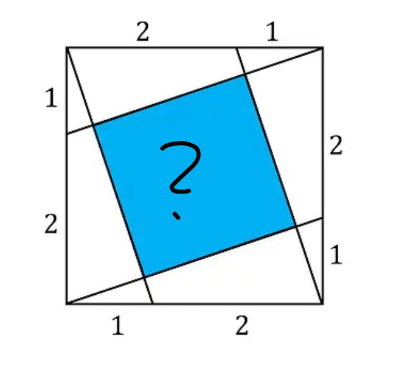
Commented by behi83417@gmail.com last updated on 18/May/20

Commented by behi83417@gmail.com last updated on 19/May/20
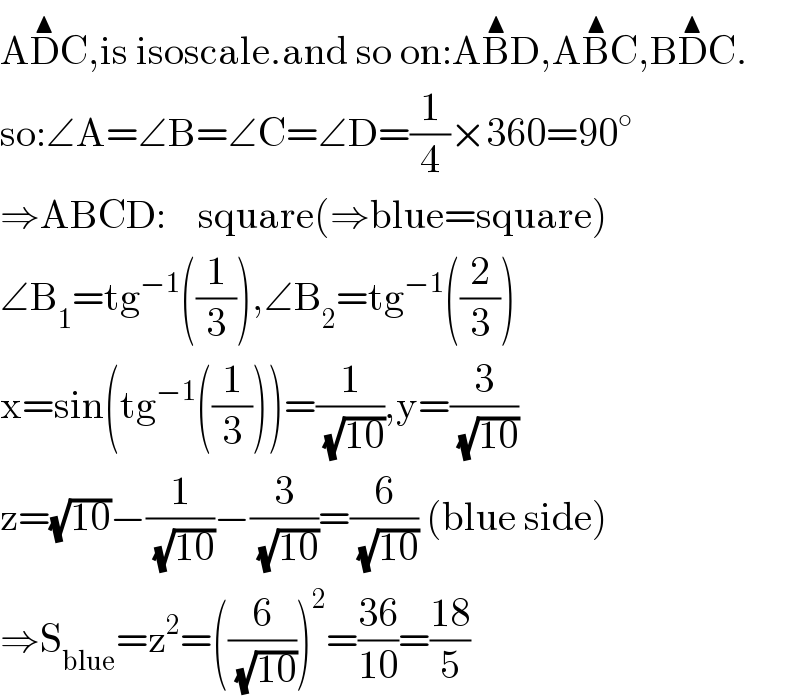
$$\mathrm{A}\overset{\blacktriangle} {\mathrm{D}C},\mathrm{is}\:\mathrm{isoscale}.\mathrm{and}\:\mathrm{so}\:\mathrm{on}:\mathrm{A}\overset{\blacktriangle} {\mathrm{B}D},\mathrm{A}\overset{\blacktriangle} {\mathrm{B}C},\mathrm{B}\overset{\blacktriangle} {\mathrm{D}C}. \\ $$$$\mathrm{so}:\angle\mathrm{A}=\angle\mathrm{B}=\angle\mathrm{C}=\angle\mathrm{D}=\frac{\mathrm{1}}{\mathrm{4}}×\mathrm{360}=\mathrm{90}^{\circ} \\ $$$$\Rightarrow\mathrm{ABCD}:\:\:\:\:\mathrm{square}\left(\Rightarrow\mathrm{blue}=\mathrm{square}\right) \\ $$$$\angle\mathrm{B}_{\mathrm{1}} =\mathrm{tg}^{−\mathrm{1}} \left(\frac{\mathrm{1}}{\mathrm{3}}\right),\angle\mathrm{B}_{\mathrm{2}} =\mathrm{tg}^{−\mathrm{1}} \left(\frac{\mathrm{2}}{\mathrm{3}}\right) \\ $$$$\mathrm{x}=\mathrm{sin}\left(\mathrm{tg}^{−\mathrm{1}} \left(\frac{\mathrm{1}}{\mathrm{3}}\right)\right)=\frac{\mathrm{1}}{\:\sqrt{\mathrm{10}}},\mathrm{y}=\frac{\mathrm{3}}{\:\sqrt{\mathrm{10}}} \\ $$$$\mathrm{z}=\sqrt{\mathrm{10}}−\frac{\mathrm{1}}{\:\sqrt{\mathrm{10}}}−\frac{\mathrm{3}}{\:\sqrt{\mathrm{10}}}=\frac{\mathrm{6}}{\:\sqrt{\mathrm{10}}}\:\left(\mathrm{blue}\:\mathrm{side}\right) \\ $$$$\Rightarrow\mathrm{S}_{\mathrm{blue}} =\mathrm{z}^{\mathrm{2}} =\left(\frac{\mathrm{6}}{\:\sqrt{\mathrm{10}}}\right)^{\mathrm{2}} =\frac{\mathrm{36}}{\mathrm{10}}=\frac{\mathrm{18}}{\mathrm{5}} \\ $$
Answered by MJS last updated on 18/May/20
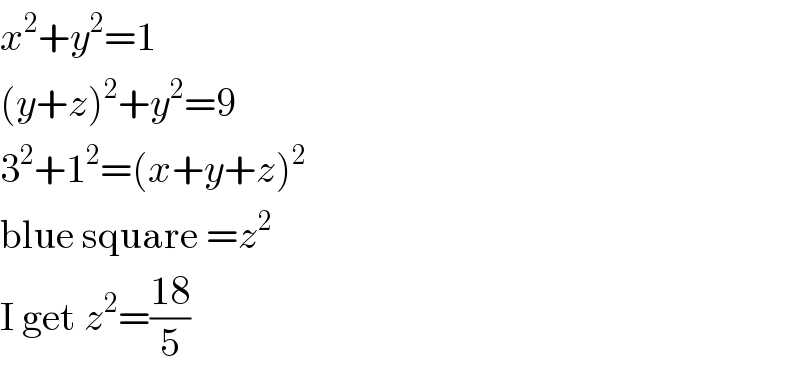
$${x}^{\mathrm{2}} +{y}^{\mathrm{2}} =\mathrm{1} \\ $$$$\left({y}+{z}\right)^{\mathrm{2}} +{y}^{\mathrm{2}} =\mathrm{9} \\ $$$$\mathrm{3}^{\mathrm{2}} +\mathrm{1}^{\mathrm{2}} =\left({x}+{y}+{z}\right)^{\mathrm{2}} \\ $$$$\mathrm{blue}\:\mathrm{square}\:={z}^{\mathrm{2}} \\ $$$$\mathrm{I}\:\mathrm{get}\:{z}^{\mathrm{2}} =\frac{\mathrm{18}}{\mathrm{5}} \\ $$
Answered by john santu last updated on 19/May/20

$$\frac{\mathrm{blue}\:\mathrm{area}}{\mathrm{square}\:\mathrm{area}}\:=\:\frac{\mathrm{2}}{\mathrm{5}} \\ $$$$\mathrm{then}\:\mathrm{blue}\:\mathrm{area}\:=\:\frac{\mathrm{2}}{\mathrm{5}}×\mathrm{9}\:=\:\frac{\mathrm{18}}{\mathrm{5}} \\ $$
Commented by mr W last updated on 19/May/20

$${thank}\:{you}\:{all}\:{for}\:{different}\:{ways}! \\ $$
Answered by mr W last updated on 19/May/20
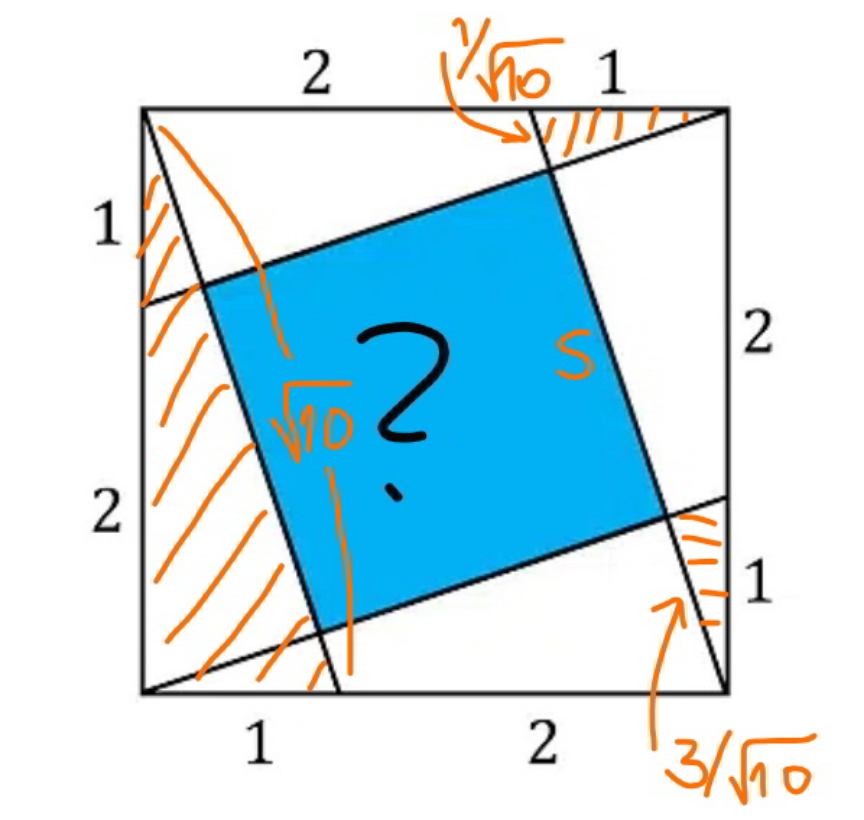
Commented by mr W last updated on 19/May/20
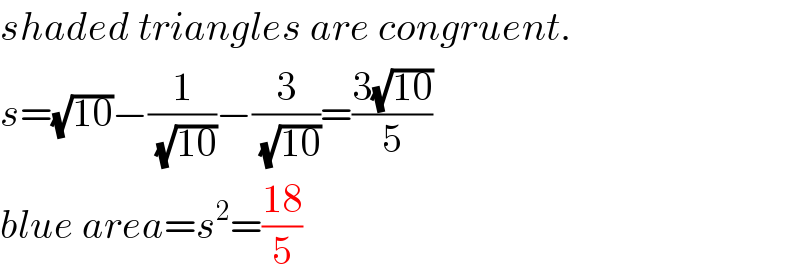
$${shaded}\:{triangles}\:{are}\:{congruent}. \\ $$$${s}=\sqrt{\mathrm{10}}−\frac{\mathrm{1}}{\:\sqrt{\mathrm{10}}}−\frac{\mathrm{3}}{\:\sqrt{\mathrm{10}}}=\frac{\mathrm{3}\sqrt{\mathrm{10}}}{\mathrm{5}} \\ $$$${blue}\:{area}={s}^{\mathrm{2}} =\frac{\mathrm{18}}{\mathrm{5}} \\ $$
Commented by mr W last updated on 19/May/20
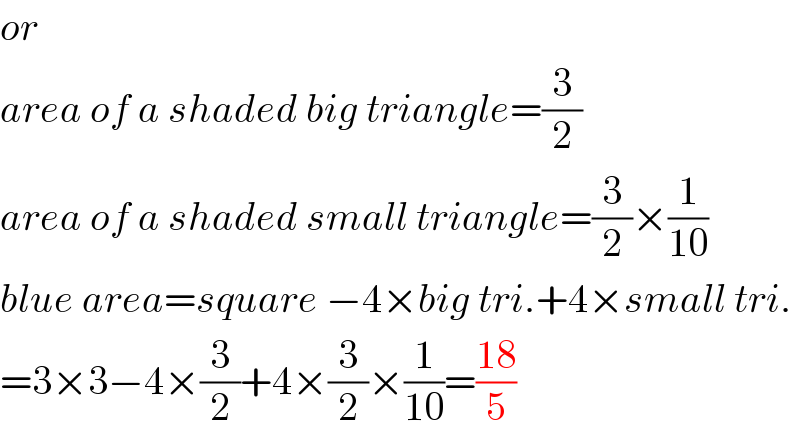
$${or} \\ $$$${area}\:{of}\:{a}\:{shaded}\:{big}\:{triangle}=\frac{\mathrm{3}}{\mathrm{2}} \\ $$$${area}\:{of}\:{a}\:{shaded}\:{small}\:{triangle}=\frac{\mathrm{3}}{\mathrm{2}}×\frac{\mathrm{1}}{\mathrm{10}} \\ $$$${blue}\:{area}={square}\:−\mathrm{4}×{big}\:{tri}.+\mathrm{4}×{small}\:{tri}. \\ $$$$=\mathrm{3}×\mathrm{3}−\mathrm{4}×\frac{\mathrm{3}}{\mathrm{2}}+\mathrm{4}×\frac{\mathrm{3}}{\mathrm{2}}×\frac{\mathrm{1}}{\mathrm{10}}=\frac{\mathrm{18}}{\mathrm{5}} \\ $$
Commented by PRITHWISH SEN 2 last updated on 19/May/20

$$\mathrm{Actually}\:\mathrm{I}\:\mathrm{am}\:\mathrm{waiting}\:\mathrm{for}\:\mathrm{something}\:\mathrm{different} \\ $$$$\mathrm{like}\:\mathrm{this}.\: \\ $$
Commented by mr W last updated on 19/May/20

$${please}\:{show}\:{us}\:{this}\:{something}\:{different} \\ $$$${sir}!\: \\ $$
Commented by PRITHWISH SEN 2 last updated on 19/May/20
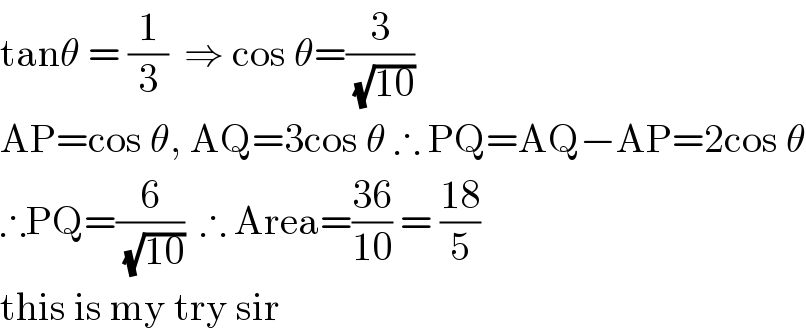
$$\mathrm{tan}\theta\:=\:\frac{\mathrm{1}}{\mathrm{3}}\:\:\Rightarrow\:\mathrm{cos}\:\theta=\frac{\mathrm{3}}{\:\sqrt{\mathrm{10}}} \\ $$$$\mathrm{AP}=\mathrm{cos}\:\theta,\:\mathrm{AQ}=\mathrm{3cos}\:\theta\:\therefore\:\mathrm{PQ}=\mathrm{AQ}−\mathrm{AP}=\mathrm{2cos}\:\theta \\ $$$$\therefore\mathrm{PQ}=\frac{\mathrm{6}}{\:\sqrt{\mathrm{10}}}\:\:\therefore\:\mathrm{Area}=\frac{\mathrm{36}}{\mathrm{10}}\:=\:\frac{\mathrm{18}}{\mathrm{5}} \\ $$$$\mathrm{this}\:\mathrm{is}\:\mathrm{my}\:\mathrm{try}\:\mathrm{sir} \\ $$
Commented by PRITHWISH SEN 2 last updated on 19/May/20
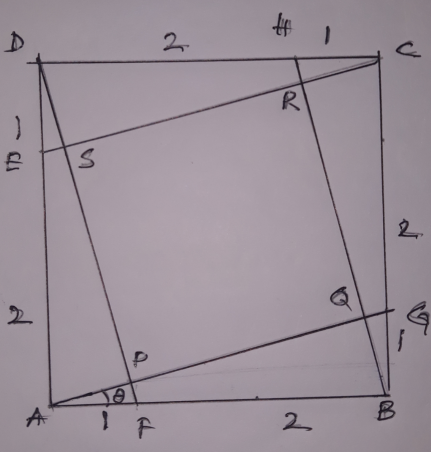
Commented by PRITHWISH SEN 2 last updated on 19/May/20
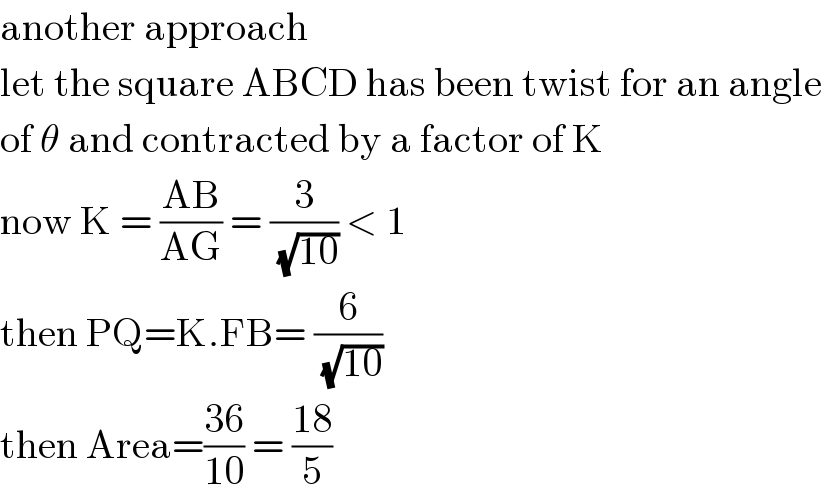
$$\mathrm{another}\:\mathrm{approach} \\ $$$$\mathrm{let}\:\mathrm{the}\:\mathrm{square}\:\mathrm{ABCD}\:\mathrm{has}\:\mathrm{been}\:\mathrm{twist}\:\mathrm{for}\:\mathrm{an}\:\mathrm{angle} \\ $$$$\mathrm{of}\:\theta\:\mathrm{and}\:\mathrm{contracted}\:\mathrm{by}\:\mathrm{a}\:\mathrm{factor}\:\mathrm{of}\:\mathrm{K} \\ $$$$\mathrm{now}\:\mathrm{K}\:=\:\frac{\mathrm{AB}}{\mathrm{AG}}\:=\:\frac{\mathrm{3}}{\:\sqrt{\mathrm{10}}}\:<\:\mathrm{1}\: \\ $$$$\mathrm{then}\:\mathrm{PQ}=\mathrm{K}.\mathrm{FB}=\:\frac{\mathrm{6}}{\:\sqrt{\mathrm{10}}} \\ $$$$\mathrm{then}\:\mathrm{Area}=\frac{\mathrm{36}}{\mathrm{10}}\:=\:\frac{\mathrm{18}}{\mathrm{5}} \\ $$
Commented by PRITHWISH SEN 2 last updated on 19/May/20
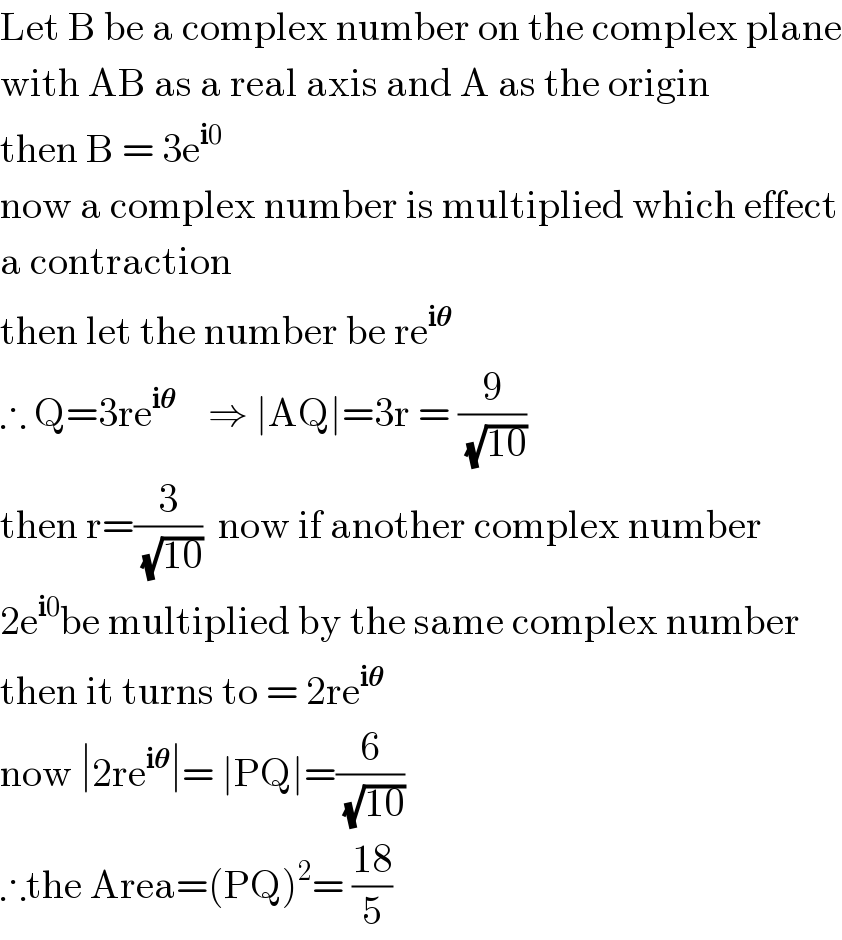
$$\mathrm{Let}\:\mathrm{B}\:\mathrm{be}\:\mathrm{a}\:\mathrm{complex}\:\mathrm{number}\:\mathrm{on}\:\mathrm{the}\:\mathrm{complex}\:\mathrm{plane} \\ $$$$\mathrm{with}\:\mathrm{AB}\:\mathrm{as}\:\mathrm{a}\:\mathrm{real}\:\mathrm{axis}\:\mathrm{and}\:\mathrm{A}\:\mathrm{as}\:\mathrm{the}\:\mathrm{origin} \\ $$$$\mathrm{then}\:\mathrm{B}\:=\:\mathrm{3e}^{\boldsymbol{\mathrm{i}}\mathrm{0}} \\ $$$$\mathrm{now}\:\mathrm{a}\:\mathrm{complex}\:\mathrm{number}\:\mathrm{is}\:\mathrm{multiplied}\:\mathrm{which}\:\mathrm{effect} \\ $$$$\mathrm{a}\:\mathrm{contraction}\: \\ $$$$\mathrm{then}\:\mathrm{let}\:\mathrm{the}\:\mathrm{number}\:\mathrm{be}\:\mathrm{re}^{\boldsymbol{\mathrm{i}\theta}} \\ $$$$\therefore\:\mathrm{Q}=\mathrm{3re}^{\boldsymbol{\mathrm{i}\theta}} \:\:\:\:\Rightarrow\:\mid\mathrm{AQ}\mid=\mathrm{3r}\:=\:\frac{\mathrm{9}}{\:\sqrt{\mathrm{10}}} \\ $$$$\mathrm{then}\:\mathrm{r}=\frac{\mathrm{3}}{\:\sqrt{\mathrm{10}}}\:\:\mathrm{now}\:\mathrm{if}\:\mathrm{another}\:\mathrm{complex}\:\mathrm{number} \\ $$$$\mathrm{2e}^{\boldsymbol{\mathrm{i}}\mathrm{0}} \mathrm{be}\:\mathrm{multiplied}\:\mathrm{by}\:\mathrm{the}\:\mathrm{same}\:\mathrm{complex}\:\mathrm{number} \\ $$$$\mathrm{then}\:\mathrm{it}\:\mathrm{turns}\:\mathrm{to}\:=\:\mathrm{2re}^{\boldsymbol{\mathrm{i}\theta}} \\ $$$$\mathrm{now}\:\mid\mathrm{2re}^{\boldsymbol{\mathrm{i}\theta}} \mid=\:\mid\mathrm{PQ}\mid=\frac{\mathrm{6}}{\:\sqrt{\mathrm{10}}}\: \\ $$$$\therefore\mathrm{the}\:\mathrm{Area}=\left(\mathrm{PQ}\right)^{\mathrm{2}} =\:\frac{\mathrm{18}}{\mathrm{5}} \\ $$
Commented by mr W last updated on 19/May/20

$${great}! \\ $$
Commented by PRITHWISH SEN 2 last updated on 19/May/20

$$\mathrm{No}\:\mathrm{sir}\:,\mathrm{yours}\:\mathrm{is}\:\mathrm{beautiful}\:\mathrm{as}\:\mathrm{it}\:\mathrm{is}\:\mathrm{simple}.\:\mathrm{I}\:\mathrm{wish} \\ $$$$\mathrm{one}\:\mathrm{day}\:\mathrm{I}\:\mathrm{will}\:\:\mathrm{able}\:\mathrm{to}\:\mathrm{think}\:\mathrm{like}\:\mathrm{you}.\:\mathrm{Thank}\:\mathrm{you} \\ $$$$\mathrm{sir}. \\ $$
Commented by mr W last updated on 19/May/20

$${sometimes}\:{it}'{s}\:{a}\:{nice}\:{feeling}\:{to} \\ $$$${search}\:{for}\:{or}\:{even}\:{to}\:{find}\:{that} \\ $$$${something}\:{different}. \\ $$
